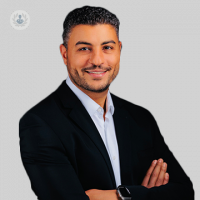What is Valve Sparing Aortic Root Replacement (VSRR)?
Escrito por:Valve Sparing Aortic Root Replacement (VSRR) is a procedure which can be used to treat aortic aneurysms. Leading cardiac and aortic surgeon Mr Ahmed Othman describes the surgery, explaining why it is beneficial and who it is suitable for.

What is Valve Sparing Aortic Root Replacement (VSRR)?
Aortic aneurysms (swelling of the aorta) that originate close to the aortic valve can cause the aortic valve to leak back into the heart. When this aneurysm reaches a certain size, or when the aortic valve leak is significant enough, it would be safer to replace the aortic wall with a synthetic graft than to leave it. This is an operation that is done regularly in centres of aortic expertise, called aortic root replacement.
In the majority of these situations, by cutting out the aneurysm and restoring the normal aortic size, the leaking aortic valve can be made competent again, without the need to replace it. This operation is called valve sparing root replacement.
Why is it useful to keep my own valve and not replace it?
Replacing the aortic valve is a technically feasible procedure. However, the prosthetic valves available, despite working very well, have disadvantages compared to having your own, well-functioning valve. One type, the mechanical valve, has acceptable durability, but has the downside of requiring lifelong blood thinners.
Unfortunately, these blood thinners are not suitable to take in older patients, patients with clotting disorders, patients of child-bearing age and those leading an active lifestyle.
There is an alternative option available, named the bioprosthetic valve, which has the downside of having a lifespan of around 15 years and therefore is not suitable for younger patients because they will require further surgery in the future.
Retaining your own valve via a valve sparing aortic root replacement (VSRR) has the benefit of not requiring lifelong blood thinners, and will have a much longer lifespan than aforementioned valve options. You will also have a lower risk of infection and the blood flow across the valve will be more physiological.
Am I suitable for a VSRR?
Before undergoing the procedure, your aortic valve needs to be assessed accurately for “repairability”; it needs to be free of disease. This will be determined with an echocardiogram (heart scan).
In some cases, patients may require a transoesophageal echocardiogram, which is a highly accurate type of heart scan using a probe that goes down the food pipe. You will need to be seen by a specialist in this type of operation.
I have a Bicuspid Aortic Valve. Am I still suitable for Valve Sparing Root Replacement?
Many aortic root aneurysms are associated with bicuspid aortic valves. The same rule applies; if your valve is free of disease, a valve sparing aortic root replacement could be performed, with excellent durability.
If you are eligible for valve sparing aortic root replacement and would like to book a consultation with Mr Othman, simply visit his Top Doctors profile today.


